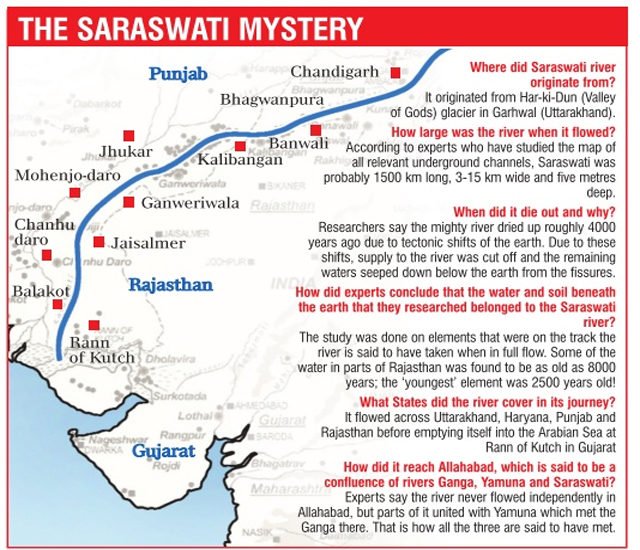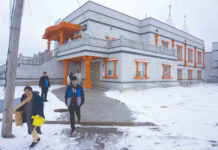By Gurmukh Singh
TORONTO: As the Maha Kumbh Mela at Allahabad is about to come to an end, millions and millions of people must have taken a holy dip at the Sangam (merger) of the three rivers – the Ganga, the Yamuna and the Saraswati.
The first two rivers are visible to everyone, but where is the invisible Saraswati river?
We have only read about this mythical river in the scriptures. So where was the Saraswati river, if it ever flowed? When did it go missing and where?
This is my article that appeared in the Times of India in July 1992 on the missing river and how it still flows under the surface! Here is the article:
By Gurmukh Singh
JODHPUR, July 23, 1992: The legendary Saraswati once flowed through India’s Thar desert.
Scientists at the Central Arid Zone Research Institute (CAZRI) here in Jodhpur have confirmed this after extensive research on the likely courses of the Saraswati, referred to as the “mother of rivers” in the Rig Veda.
Earlier, the scholars had identified the river with the present dry bed of the Ghaggar in Haryana and Rajasthan and the Raini, the Wahinda and the Nara streams in Pakistan. Though it was agreed that the river frequently shifted its course, it could not be traced from its source in the Shivalik hills in the Himalayas to the estuary.
Now through satellite imagery, aerial photographs and field surveys, CAZRI scientists have confirmed that this mighty river first of all ran through the Thar desert and then shifted its course westward.
“It is estimated that the river flowed through the Thar desert between one million and 40,000 years ago and then shifted westward. The present Ghaggar valley took shape when the Saraswati ran through this course,” says Dr Amal Kar, senior geomorphologist at CAZRI.
The scientists have constructed the earliest course of the Saraswati through the towns and cities of Nohar, Surjansar, Sirsa, Lunkanasar and Bikaner, and Pachpadra where this sacred river was met by the present river Luni.
One outlet of the Saraswati into the sea was at Lakhpat (in Gujarat) which was also a major seat of learning and a port. Further downstream, was Narayan Sarovar which is mentioned in the Mahabharata as a holy place.
“Then climatic changes and earthquakes (the Rann of Kutch is prone to tectonic activities) forced the river to change its course and move westward. Climatic changes also induced aridity which caused the sand to choke off the river course,” says Dr Kar.
Subsequently, the river occupied what is now known as the dry bed of the Ghaggar between Nohar and Anupgarh. “Here pre-Harappan and Harappan civilizations flourished at Alibangan and Pilibangan. Later, another civilization thrived at Rangmahal (near the present-day Hanumangarh in Rajasthan),” says Dr Kar.
According to Dr Amal Kar, beyond Anupgarh the river used to flow through Sakli, Islamgarh (in Pakistan), Ghantial, Shahgarh (in Jaisalmer district), and Mahilamungra (in Pakistan) and then through the present course of the Nara. More shifts took place later on and the river identified itself with the Raini, the Ahindi, and the Hakra Nara in Pakistan. Later, the Saraswati joined the Sutlej near Ahmedpur (East) in Pakistan.
Says Dr Kar, “Earlier, the Sutlej – known as the Satadru in the Vedic period – used to be a tributary of the Saraswati first joining it near Jakhal and later near Hanumangarh and Anupgarh. During the Mahabharata period when the Sutlej moved away from the river (due to tectonic and climatic reasons), the Saraswati was left with its own meagre flow, leaving a dry valley,” Dr Kar explains.
During the Mahabharata period, the Saraswati or the Sapta Saraswati (system of seven rivers) is referred to as a dying river which went underground near Binasan. “This place is near present-day Sirsa in Haryana,” Kar says.
Another main tributary of the Saraswati, according to the Mahabharata, was the Drishadvati which used to merge with the Saraswati after flowing through Jind, Narnaul, Hissar and Nohar. Scholars have identified the Drishadvati river with the present-day Chautang, carrying the Hansi-Hissar branch of the western Yamuna canal.
Even today, the buried courses of the Saraswati still yields sub-surface water in the Rajasthan desert. “This sub-surface water in the desert comes from the Himalayan precipitation that flows through the buried courses of the Saraswati. Since the meagre rainfall (150mm) here in the Rajasthan desert cannot contribute substantially to the perennial supply of sub-surface water, it is the quietly flowing Saraswati under the sub-surface of earth that is the source of year-round sub-surface water here,” says Dr Kar .
Field investigation by the researchers had confirmed the existence of buried courses of the Saraswati river. It has been found that the areas through which the Saraswati flowed supports lush green vegetation today even during the summer months in the desert. In fact, some wells dug along the buried course of the Saraswati have yielded sweet water only at 30 to 40 metres. That is a miracle in the Thar desert.
It means the Saraswati is still flowing quietly subterraneanly (under the sub-surface).
READ NEXT: Kedarnath shrine – now and then
ALSO READ: BAPS Swaminarayan Temple in Toronto to last one thousand years









Amazing
sarswati river is still here… in gujrat anf it not ended in kutch bt its long … in siddhpur… (shree sthal) .. its available.. go nd check
amazing story of saraswati river
Best information about sarswati river.